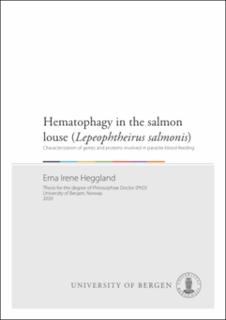| dc.description.abstract | The salmon louse (Lepeophtheirus salmonis) is an obligate, hematophagous ectoparasite infecting salmonid fish such as the Atlantic salmon (Salmo salar). The parasite is at present the number one threat to the Norwegian salmon farming industry. There is a high density of hosts in salmon farms, and due to the high mutation rate and fecundity of the parasite, the salmon louse is currently ahead of the development of effective pest controls. Resistance has been reported against several available chemotherapeutants, and non-therapeutic interventions are as per now not sufficient to treat salmon louse infestations. Particularly adult female lice have blood as a major dietary component. This is a high-risk, high-reward strategy which the parasite is well-adapted to. Blood is highly nutritious and constantly renewed in the vertebrate host, but also contains toxic, yet necessary, compounds such as iron and heme (iron protoporphyrin IX). The salmon louse is likely a heme auxotroph, as many homologous enzymes of the conserved heme biosynthetic pathway are not found within its genome. As such, the salmon louse is innately dependent on its host for iron and heme supply. Blood-feeding and subsequent iron and heme trafficking are thus essential to study in the salmon louse, and could potentially reveal candidate proteins for pest management by e.g. vaccination or nutritional deprivation. Ferritin is a well-conserved multi-subunit iron storage and distribution protein that can be either cytosolic or secreted. In the present study, several ferritin-encoding genes were identified in the salmon louse genome (LsFer1, 2, 3 and 4). Secreted heavy chain homolog (LsFer1) and secreted light chain homolog (LsFer2) transcripts were found to be expressed in the salmon louse intestine, where the precursor protein is probably loaded with iron intracellularly before it is secreted to the hemolymph. RNA interference-mediated knockdown of these two transcripts resulted in severe phenotype alterations for the adult female salmon louse. In both knockdown groups, it was unable to produce proper egg strings, and with an almost complete egg hatching failure. Histological sections of knockdown animal genital segments revealed that the developing oocytes lacked the structure and integrity seen in normal developing oocytes. Furthermore, the knockdown animals lacked the ability to fully engorge in salmon blood. Additionally, in wildtype lice, the transcript levels of LsFer1 and LsFer2 were decreasing during starvation, further indicating the importance of these genes in relation to the blood meal. Further, an investigation of a CD36-like protein named L. salmonis heme scavenger receptor class B (LsHSCARB) was performed. The transcript and protein were located to the salmon louse intestine. The receptor has an extracellular domain likely facing the intestinal lumen. The postulation was that the domain could scavenge host-derived heme. The domain was able to bind to heme in silico as demonstrated by ligand docking using bioinformatical tools. The receptor was also able to bind heme in vitro, as shown using a recombinantly expressed protein in a hemin-agarose pull down assay. During a starvation period, the transcript levels of LsHSCARB in the adult female salmon louse decreased steadily, suggesting that the receptor is down-regulated by the absence of a food source. RNAi mediated receptor ablation in vivo led to a decrease in absorbed heme levels in salmon louse tissues, and knockdown animals had shorter egg strings with a lower hatching success. Because having blood as a diet requires proper handling of blood-components, a hypothesis was that initiating in blood-feeding would to a shift in the salmon louse transcriptome. Results in this thesis indicate that the salmon louse normally starts feeding on blood in the mobile preadult I stage, but that those lice that were attached to the vascular fish gills were feeding on blood already in the chalimus I stage. The lice attached to the gills also developed at a slower pace than those lice elsewhere on the host. Chalimus larvae located on gills were therefore sampled for RNA-sequencing and subsequent gene expression analyses, and compared to chalimus larvae from host fins and general body surfaces, that were of similar instar age. Several transcripts were found differentially expressed in chalimus larvae on gills, among these ferritins, digestive enzymes, genes of unknown functions and genes with FNII domains, to mention some. These genes could be vital for blood-feeding in the salmon louse. Combined, these results stress the importance for the salmon louse to maintain proper ways of handling the blood meal, particularly the micronutrients iron and heme. This thesis builds on the little knowledge on iron and heme biology in L. salmonis from earlier, and provides a further understanding of salmon louse hematophagy. The results of this thesis could possibly be used to lay the groundwork for future methods of controlling the salmon louse infestations in the salmon aquaculture. | en_US |
| dc.relation.haspart | Paper II: Erna Irene Heggland, Christiane Eichner, Svein Isungset Støve, Aurora Martinez, Frank Nilsen & Michael Dondrup (2019). «A scavenger receptor B (CD36)-like protein is a potential mediator of intestinal heme absorption in the hematophagous ectoparasite Lepeophtheirus salmonis». Scientific Reports 9, pp. 1-14. The article is available in the thesis file. The article is also available at: <a href="http://doi.org/10.1038/s41598-019-40590-x" target="blank">http://doi.org/10.1038/s41598-019-40590-x</a>. | en_US |

